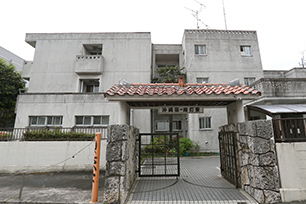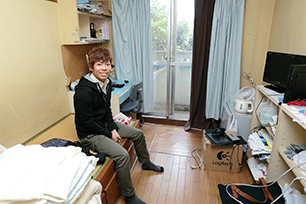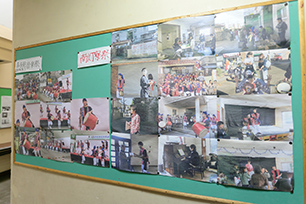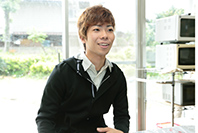The Life of a Keio Student (3)
Building friendship through Okinawan traditions
Okinawa Prefecture Student Dormitory "Nanto-ryo" (Komae City, Tokyo)
Yudai Kinjo, from Okinawa Prefecture, lives in the Okinawa Prefecture student dormitory, known as Nanto-ryo. For a reasonable monthly rent of 42,000 yen, students receive their own individual room, two meals a day (except on Sundays), and a fixed amount of utilities (students who exceed this amount pay extra but usually no more than 1000 yen). However, students' period of stay is limited to half of the minimum time it takes to complete their course; in the case of four-year university students, this means they can only stay for two years. Residents come together to perform eisa, a style of folk dance originating from Okinawa, at celebrations and festivals.

Second-year, Faculty of Science and Technology



——Why did you choose to live at the Okinawa Prefecture student dormitory?
Yudai: My parents suggested it to me when I was getting ready to go to Keio. As it was going to be my first time living in Tokyo, I guess they thought that I would feel more comfortable with friends from home around me. Personally, I was interested in living alone, but now I'm glad that I chose the dormitory. Back in Okinawa, I spent my high school years living in a dormitory in Naha, several hours from my hometown Nago, so I was already used to living with other people.
——There are shisa lions on the gate and cycad plants in the gardens. It really feels like Okinawa!
Yudai: Actually, I'm not really aware of that, but I did find that during those first few weeks of school I was able to forget my nerves and stress as soon as I walked in the door of the dorm. For example, in Tokyo people address each other with their surnames, whereas in Okinawa we call each other by our first names. So here everyone calls me "Yudai"--even the girls! It really makes me feel at home!
——Girls?! But this is a male dormitory...
Yudai: Yes, this dormitory is for male students, but there's a dormitory for women too, and we see each other at each dormitory's festival. It's our tradition to dance eisa together at each festival, and at the celebrations commemorating the reversion of Okinawa to Japan we dance and play the drums in the shopping arcade near the dormitory. We hold practice in the evenings after dinner from around mid-April. Everyone gets to know each other really well at the practices. We hang out and go shopping together on days off and at the moment we are planning a trip together.

——Is there anything that you find difficult about living in the dormitory?
Yudai: Not really. We have to take turns taking out the trash, and everyone gets together to clean the corridors and canteen once a month, but I don't really mind. It's a fair price to pay for being able to make good friends outside of school. Many of the friendships made here last well into the future.
Homes away from home
Third-year Faculty of Business and Commerce student from Vietnam lodging with a Japanese family
Living as a member of a Japanese family. Experiencing daily life in Japan, with a family with three children of around the same age. Receiving a scholarship from a Japanese corporation.
"I came to Japan after I passed the Japanese Language Proficiency Test (JLPT) Level 1 and studied for a while at a language school before being accepted to Keio. I have been living with my host family since I arrived in Japan. I quickly fell in love with my host mother's Japanese-style home cooking! I talk to my family in Vietnam over the Internet three times a week, sometimes for one hour at a time, so I don't feel lonely at all. It takes me two hours to commute, but I can get to campus on time if I leave home at 7:00."
Fourth-year Faculty of Letters student from Kagawa Prefecture living at the Kagawa Ikueikai Foundation "Tokyo Student Dormitory"
Tokyo Student Dormitory run by the Kagawa Ikueikai Foundation. A 90-second walk from Mita Campus. Monthly rent: 54,000 yen, including breakfast and evening meals. Individual rooms with furniture. Residents provide their own refrigerator and television.
"I found out about the dormitory through an ad on my high school notice board. My room is only about 8.5 square meters, so my mother was worried that it would be a bit cramped, but I really like it. It's handy to have all my things within reach! I speak in our local dialect, Sanuki-ben, at the dormitory. I have made good friends with people who I had seen when I was in high school but never had the chance to get to know. When I come home from cheerleading practice totally exhausted, my friends always cheer me up. The central location is really useful when it comes to job hunting."
Student life in figures: Costs
According to the "Survey of the Current Living Conditions of Keio University Students (No.26)", the approximate monthly income of a student who lives away from home is around 140,000 yen, while students who live at home receive around 60,000 yen. The 80,000-yen difference is mainly used to cover the costs of accommodation and utilities--around 65,000 yen—and the difference in the amount spent on food and eating out; students living away from home spend 30,000 yen on food and eating out, almost double the 16,000 yen spent by students living at home. According to the results of the same biennial survey after 2000, the total income of students living away from home was around 160,000 yen from 2000 up until 2008, but decreased by approximately 12% to around 140,000 yen from 2010 onwards.
In fact, a higher proportion of students living at home have held a part-time job than students living away from home, with 63% of students living away from home, and 75% of students living at home having held a part-time job in the last year. Many students work as private tutors and cram school teachers. The top ways of using income included "food"—chosen by 47% of students living away from home and 32% of students living at home—and "entertainment and socializing"—chosen by 41% of students living away from home and 45% of students living at home. Around 11% of students, in the case of both students living at home and students living away from home, selected "books" as a means of spending their income. (Students could select up to two answers.)
The number of students who required some kind of financial aid had previously been on a constant increase, but decreased slightly following a peak in 2010. However, the proportion of students who responded that financial aid is "extremely necessary" or "moderately necessary" is as high as 58% for students living away from home and 40% for students at home.
*1 Average total income of students who responded to the survey.
*2 Average incomes from allowances from families and guardians, part-time jobs, and financial aid.
"Survey of the Current Living Conditions of Keio University Students (No.26)"
Carried out in 2012. 37% response rate.
*This article appeared in the 2013 summer edition (No.279) of “Juku”.
*Position titles, etc., are those at the time of publishing.
